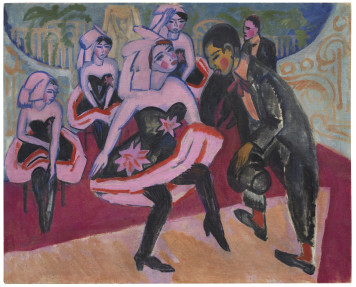Ernst Ludwig Kirchner
Tanz im Varieté by Ernst Ludwig Kirchner (1880–1938) has been part of the Im Obersteg collection since June 2024. The painting was considered lost for almost a century, when its existence was only documented by black-and-white photographs. The work was created in 1911 as one of the last works in Dresden before Kirchner moved to the German capital, Berlin.
Here Kirchner painted the cakewalk, a dance that became popular in Europe from 1900. It was created during the time of slavery in the USA to parody the dances of white culture. In the northern states, the dance was adopted by minstrel shows, in which white people performed in blackface. The cakewalk thus became a parody of the African Americans who had developed it. It was not until the turn of the century that Black dancers were allowed to perform this dance on theater stages. Performances soon took place throughout Europe, and the cakewalk found its way onto Kirchner’s canvas in Tanz im Varieté.
Dance, vaudeville, and the circus form an important cluster of motifs in Kirchner’s oeuvre. Kirchner sought his inspiration in life, in encounters between people on the street, or in vaudeville. The moving bodies of dancers appear elegant and dignified and serve as projection surfaces for the fashion and movements of their time. Kirchner uses these bodies to show the hopes and failures of a society in transition.
The work had previously been exhibited twice: in 1912, one year after its creation, as part of the first and last group exhibition of Die Brücke artists’ group in Berlin, and in 1923 in a solo exhibition dedicated to Kirchner at the Kunstsalon Paul Cassirer. It then came into the possession of a family in Baden-Württemberg via the Max Glaeser Collection.
The work remained there until its rediscovery in 2024, when its striking color scheme was revealed. With the purchase in June 2024, the Im Obersteg Foundation came into possession of a painting from the “best Brücke period,” whose motif has captured the ravages of its time. In its mania, Tanz im Varieté precedes Kirchner’s famous Berlin street scenes, which were created from 1913 onwards.
